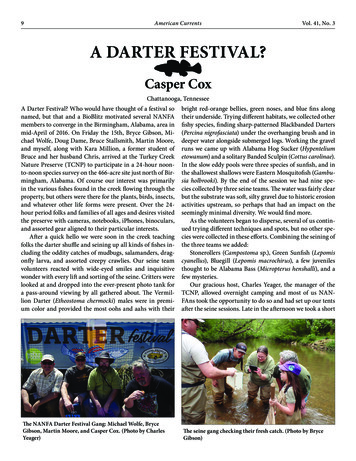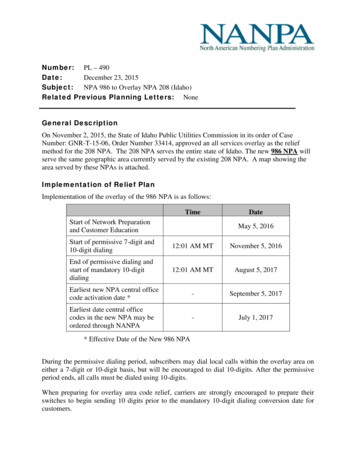
Transcription
9American Currents Vol. 41, No. 3A DARTER FESTIVAL?Casper CoxChattanooga, TennesseeA Darter Festival? Who would have thought of a festival sonamed, but that and a BioBlitz motivated several NANFAmembers to converge in the Birmingham, Alabama, area inmid-April of 2016. On Friday the 15th, Bryce Gibson, Michael Wolfe, Doug Dame, Bruce Stallsmith, Martin Moore,and myself, along with Kara Million, a former student ofBruce and her husband Chris, arrived at the Turkey CreekNature Preserve (TCNP) to participate in a 24-hour noonto-noon species survey on the 466-acre site just north of Birmingham, Alabama. Of course our interest was primarilyin the various fishes found in the creek flowing through theproperty, but others were there for the plants, birds, insects,and whatever other life forms were present. Over the 24hour period folks and families of all ages and desires visitedthe preserve with cameras, notebooks, iPhones, binoculars,and assorted gear aligned to their particular interests.After a quick hello we were soon in the creek teachingfolks the darter shuffle and seining up all kinds of fishes including the oddity catches of mudbugs, salamanders, dragonfly larva, and assorted creepy crawlies. Our seine teamvolunteers reacted with wide-eyed smiles and inquisitivewonder with every lift and sorting of the seine. Critters werelooked at and dropped into the ever-present photo tank fora pass-around viewing by all gathered about. The Vermillion Darter (Etheostoma chermocki) males were in premium color and provided the most oohs and aahs with theirThe NANFA Darter Festival Gang: Michael Wolfe, BryceGibson, Martin Moore, and Casper Cox. (Photo by CharlesYeager)bright red-orange bellies, green noses, and blue fins alongtheir underside. Trying different habitats, we collected otherfishy species, finding sharp-patterned Blackbanded Darters(Percina nigrofasciata) under the overhanging brush and indeeper water alongside submerged logs. Working the gravelruns we came up with Alabama Hog Sucker (Hypenteliumetowanum) and a solitary Banded Sculpin (Cottus carolinae).In the slow eddy pools were three species of sunfish, and inthe shallowest shallows were Eastern Mosquitofish (Gambusia holbrooki). By the end of the session we had nine species collected by three seine teams. The water was fairly clearbut the substrate was soft, silty gravel due to historic erosionactivities upstream, so perhaps that had an impact on theseemingly minimal diversity. We would find more.As the volunteers began to disperse, several of us continued trying different techniques and spots, but no other species were collected in these efforts. Combining the seining ofthe three teams we added:Stonerollers (Campostoma sp.), Green Sunfish (Lepomiscyanellus), Bluegill (Lepomis macrochirus), a few juvenilesthought to be Alabama Bass (Micropterus henshalli), and afew mysteries.Our gracious host, Charles Yeager, the manager of theTCNP, allowed overnight camping and most of us NANFAns took the opportunity to do so and had set up our tentsafter the seine sessions. Late in the afternoon we took a shortThe seine gang checking their fresh catch. (Photo by BryceGibson)
Summer 2016American Currents 10Buckeye flowering and the stone arched swinging bridgecrossing to the far side of Turkey Creek. (Photo by CasperCox)Michael in his element. (Photo by Bryce Gibson)BioBlitz Seine Team 2016, a partial assemblage. NANFAmembers Wolfe, Yankeetown Doug, Photog Bryce and assorted stream shufflers. (Photo by Casper Cox)walk down the preserve’s road to watch a hawk release andto check out a different section of the creek, an area withmore rugged terrain and small rapid runs feeding into adeep-flowing pool. Upon arriving Charles noticed an Eastern Kingsnake (Lampropeltis getulus) trailside and caught itby the tail, sharing it with all those who gathered around. Itwas relatively calm and only bit one of the fellas handling itas the children gathered close with wide eyes. A lady ornithologist arrived with a young hawk that had been rescuedfrom starvation as a young fledging. With proper feedingsit had been returned to health and after a short talk wewatched as the hawk was released and flew free. She spoke ofseveral owls being released at the preserve, and perhaps thathelped explain our close encounter with a Barred Owl (Strixvaria) as it had landed just above our seining activity earlierin the day. “Who cooks for you?” it called.Upon returning to the campsite we realized we were notthe only ones who would be camping overnight as the smallfield was scattered full with all manner of tents and vehicles. I was a bit worried as most of them were young highTurkey Creek tumbling down, snorkelers beware. (Photo byBryce Gibson)schoolers and I thought we would be in for a long night ofloud raucous behaviors, but they were quite well manneredthroughout the evening.Across the creek, tables were set on the porch of thehistoric cabin overlooking the swinging bridge and flowing water below. On the tables an evening meal of chili andstew were complemented with pans of cornbread along withdrinks and desserts of all kinds, wonderfully provided bythe Friends of Turkey Creek Nature Preserve. After fillingour plates, we gathered at the far end of the porch beyondthe rocking chairs and caught up with the day’s activitiesamongst ourselves along with other fellow BioBlitzers sittingnearby. Everyone was happily content and enjoyed themselves on such a fine late afternoon as the day’s last lightfaded into the evening.A bit fatigued from the day’s activities, I laid down inmy van and quickly fell asleep while the others took a walkinto the night with flashlights and hoot owl callings. A sheetstretched white, tight, and illuminated bright, attractednight flying insects and all manner of moths, including a
11American Currents Luna (Actias luna). I would have enjoyed that surely but sleephad taken hold of me. I awoke about midnight as a groupof fellas chattered from hammocks strung nearby, so I tooka walk looking for the fish blitzers and found the campfireburning low with only one fella, sitting quietly and shininghis light on the whispering tents. He was the youth ministerfor the well-mannered camping youngsters. We talked a bitand so ended the evening.Vol. 41, No. 3DAY TWOAfter a night’s rest, an early morning breakfast was provided to all attendees and campers. Again the tables were laidout with options of a variety of egg dishes and grits alongwith juice and coffee. After the complimentary breakfast,the NANFA members broke into two groups of three: Bruceleading Doug and Martin on a seining quest to verify thepossibility of a Burrhead Shiner (Notropis asperifrons) sighting from the day before, which they did find and photograph, while Bryce, Michael, and myself drove a few milesupstream to a headwater spring at which all three speciesof darters were said to be found or just a bit downstream.Turkey Creek was a good bit clearer here today and beingthe first snorkeler in the water I was soon face to face withfully colored pearlescent Striped Shiners (Luxilus chrysocephalus), their faces patterned with tubercules and territorially active over the clean gravel run. I soon sighted several Blackbanded Darters, their markings darkening as theywere flushed out from beneath logs and brush. Stonerollerswere common too, and I caught sight of a Blacktail ShinerA tuberculate male Stoneroller excavating a spawning pit inthe cistern’s clean gravel. (Photo by Casper Cox)Our cautious host Charles Yeager considering the newlycaught Kingsnake. (Photo by Casper Cox)Striped Shiners spawning over the freshly dug pits. (Photo byCasper Cox)
Summer 2016American Currents 12A fine pair of courting Vermillion Darters, soon spawning afuture generation for Turkey Creek’s flowing waters. (Photoby Michael Wolfe)Lush vegetation marks the habitat of the Watercress Darter.(Photo by Bruce Stallsmith)(Cyprinella venusta) speeding beyond the stonies. Proudlyposing Vermillion Darters were common, but teased myphotographic attempts by fleeing from every advance ofthe camera. A sculpin poked out from the cobble and madefor an easy portrait holding himself steady to the substratewith wide pectoral fins planted firmly by the current flowingover them. Bryce and Michael arrived and walked upstream,sending silt plumes downstream disturbing the clarity of myfishy encounters and photography attempts. I relented thespot and headed further downstream, hoping to avoid mostof their activity and intending to explore the waters beyond,but I was soon meet with rough going.My camera began to leak, so in frustration I returned tothe van to blot out the moisture and check and clean the seals.Instead of returning to the creek proper I decided to look forthe spring run’s source and after a short walk through thelong-abandoned trailer park I found it in a manmade opencistern used to pool the water for the various water lines. Theopen pool had long since deteriorated, the stone walls collapsing in several places, jutting pipes broken off here andthere, but the structure still retained about waist-deep waterand it was crystal clear. I felt the wonderful sense of floatingA healthy, wealthy Vermillionaire Male. (Photo by BryceGibson)Bryce and Michael downstream, chilling in the green, bluehole. (Photo by Casper Cox)in air. Vibrant green plants, tall trees, and flowering busheshad taken over the perimeter like a lush wall while logs andjangled broken limbs had washed in creating structure andhabitat. Several Vermillion Darter males proudly paradedalong the top of a submerged wall, stopping and displayingfor the females gathered to the sides. But again these colorful darters would only allow an approach of about two feet;any closer and they would flee only to reappear a few minutes later at their same chosen spot. My camera began toleak again so I perched it in a snag just above the surfacewhile I explored the pool’s perimeter and towards the gently flowing waters from upstream, hopefully leading me onto the spring’s source. However, just beyond the pool’s stonestructure the substrate was silty and virtually any movementwould send clouds billowing wide to the crystal-clear waters behind me. I stopped my advance but not before seeingwhat appeared to be water welling up in the distance, perhaps the spring’s origin. Turning around, a massive schoolof stonerollers cruised past me and into the shadows of thevegetated wall. But why would they gather in this quiet flow?Swimming to the open pool’s far side I found the epicenterof life, a flurry of spawning activity over clean gravel banked
13American Currents One of the ever-changing-patterned Blackbanded Darters,how mighty they be. (Photo by Michael Wolfe)high against the corner wall. Highly tuberculate stonerollerswere vigorously digging pits at several locations, spitting outmouthfuls of little stones. Over other cleared pits pearlescentStriped Shiners were nipping at each other, spinning in rapidwhirls. Long, sleek Creek Chubs (Semotilus atromaculatus),their heads tuberculate and sporting their diagnostic dorsal mark, patrolled through the activity while hundreds offish seemed to wait in the shadowed distance. I retrieved mycamera and took photos and videos pushing the camera evercloser to their activity, and for the most part the fish wereonly mildly concerned by my presence. Studying the site, Irealized the wall here was capped with woody debris andthrough it was one of the main outflows for the open cistern,the water dropping several inches to a swampy area beyond.With the camera’s viewer clouding increasingly from theleakage, I considered it better to return to the van before itshorted out and check on my snorkel buddies. I found Brycegetting out of his now wet dry suit also complaining abouthis leakage issues. I pleaded my case to beg, borrow, or stealhis backup point-and-shoot Olympus so I could return tothe pool and get a few more photos. Michael was somewheredownstream following the main creek’s flow while Brycehad pushed upstream earlier exploring the beaver pond,which I suspect was a hundred yards below the open cisternSunfish - Killifish - Minnows - DartersPhone: (330) 417-9476Email: smbass444@yahoo.comVol. 41, No. 3pool I had been in. His saturated dry suit had urged him outof the water as it was becoming burdensome and awkward.After comparing notes and observations I promised to return within the hour.Using Bryce’s camera for a few more photographs of thespawning activity, I was satisfied and while walking back Iencountered Bruce, Michael, and Martin headed to a highlyvegetated shallow area on the edge of the concrete pads. Theycommenced to setting the seine at the vegetation’s edge andI gently moved through the plants, flushing the fish towardsthe seine. In three easy set and lifts we collected several fishesand critters and put them into a viewing tank to identify. Inaddition to the aquatic insects, Gambusia, young stonerollersand chubs we had a few darters and sure enough one of themwas a fully colored male Watercress Darter (Etheostoma nuchale). Beautiful indeed! I had hoped to observe a Watercress Darter while snorkeling but this water was only inchesdeep, very silty, and seemingly not possible to snorkel in. Mylimited-experience guess is they like very shallow vegetatedwater, but with a bit of thought, scouting, and patience, onemight find an ideal site to photograph them from in the future. However, Bryce did manage to photograph an image ofa Watercress Darter downstream in the creek proper.Gathered back at the vehicles, we decided to return tothe preserve and snorkel downstream at a so-named BlueHole but today it was much more of the green-hole varietywith the visibility limited to about 3 or 4 feet. Nonethelesson the inside curve of the following creek the sun shinedbright upon the banked gravel cobble and Striped Shinerswere highly motivated here. Alabama Shiners (Cyprinellacallistia) began to appear alongside them, a few more Blacktail Shiners, and in the distance a first dorsal ray lined withblack, a redhorse. I spotted a couple of ever wary Vermillion Darters and Michael and I worked together making forcloser photographic opportunities.I decided to explore downstream, but as I stood and tooka few steps I released a torrent of silt clouds, so instead Ichoose to return up the bouldered far side bank and see thesunfish that had gathered near Bruce. He was sitting aboveon the sunlit rock watching the three of us snorkel whilechatting with all the curious folks stopping by. Bruce and Iattempted to feed the sunnies a bit of campfire Kettle Kornbut I was getting cold after several hours immersed and withthe sun getting low I had my fill of the chill.Michael and Bryce relented as well and we soon had ondry warm clothes and with Bruce bidding his farewell, andDoug having left earlier, the remaining four of us headed tothe Pinson crossroads for a Mexi meal and conversations. Ithad been quite a while since I had spent time with Martinand afterwards the four of us enjoyed the evening aroundthe campfire well into the night. The campsite was left to us
American Currents 14Summer 2016four alone, quietly peaceful, in contrast to the high population and the ongoing activities from the night before.DAY THREEWe awoke early and broke camp enjoying Martin’s tailgatebrewed coffee, and then caravanned to the mural site usingBryce’s navigational skills. It is not often you get to see a Watercress Darter painted huge on a wall but here were threepainted by Roger Peet and his assistants. We had a bit of funposing for photos and admiring the fine artistic skill but Iwas keen on getting to the Darter Festival pronto not wanting to miss the bike parade and prize-winning darter costumes. As soon as we arrived at the Good People BreweryCo., the site of the Darter Festival, Bryce found my originalcontact, Roald Hazelhoff, who had introduced me to our hostCharles. He hurriedly filled us in on the supposed agendapointing out the site across the street where the bikes andcostumes were to gather in an hour or so. Since the brewery would not open for another hour, we wandered over toBryce, Martin, Michael, and the giant Watercress Darter, enroute to the fishy festivities. (Photo by Casper Cox)Railroad Park, which is long and straight as a railroad butpleasantly features a stream flowing through the center withlandscaped sidewalks running alongside and crossed withbridges. Of course we were soon standing on the banks looking down and not too surprisingly greeted with bright orangeGoldfish (Carassius auratus) but there were other fishes tooand lots of them: shiners. Blacktail perhaps with their blackspot? Lots. Oddly no Gambusia. No topminnows, no darters. Studying them ever closely we felt like possibly AlabamaShiners too, and maybe something else, perhaps even Rainbow Shiners (Notropis chrosomus) but certainly all shinersof some sort. The water park is a closed-circulating system; Ido not think any outside waters are connected. Martin wentfurther upstream and reported a bog garden wetland but thesignage inferred that it is a closed system. We speculated onthe presence of the shiners and wondered about other speciespossibly being introduced into this manmade system. Perhaps particularly stonerollers are needed to clean the algaefrom the slimy stones placed in the long runs as well as thegravel between them. Topminnows or studfish would likelydo well and perhaps some species of local darters would sur-Friends of Turkey Creek Nature Preserve President KarenHutchinson holding a hefty Vermillion Darter. (Near lifesized it be!) (Photo by Casper Cox)
15American Currents Vol. 41, No. 3Luring in the fishes with tasty dog biscuits. (Photo by BryceGibson)The author on site with the Vermillion Darter. (Photo byBryce Gibson)vive in the small riffle areas. That would be something to askthose in charge of the park’s aquatic citizens. To stand on thebank and watch stonerollers spawn would be a mysteriousand interesting sight for most park visitors.We wandered back to the brewery as food trucks arrivedand more tents and tables were set up. Every once in a whileMartin would call out “There’s a bike!” and I would turnto see a rolling colored blur in the far distance. When andwhere was this fishy bike parade exactly? Back inside thebrewery, the Friends of Turkey Creek Nature Preserve hadset up a display that also featured three very hefty, well-crafted wooden carvings of all three darters celebrated by thefestival: Vermillion, Watercress, and Rush (E. phytophilum).We took a few photos of the goings on as more folks arrivedand shared a couple of the Good People’s Beer including theDarter Ale and aptly named Snake Handler featuring 10%alcohol. The food trucks opened for business and Bryce traded currency for a box of imported Fish & Chips while Michael went with a pair of fish tacos from the “Off The Hook”truck. I was successful in pleading a few chips from Brycealong with a small piece of tasty foreign catfish and then thesame from Martin’s purchase. I went to the bar for a CoffeeOatmeal Brew to share with the others and grabbed a coupleof dog biscuits from the bar top’s jar. Where were the typicalpeanuts and just who is eating these dog biscuits?Out on the loading dock the Steel City Jug Slammerswere playing their wacky sounds as folks enjoyed their beeror played a teetering, towering version of 2x4 Jenga. Downon the gravel lot folks were tossing bean bags at corn holes,and that ain’t the way I remember it. With a donation youcould tour the inner workings of the brewery and indeedsome had made the contribution and were also treated toa spread of bratwurst, sauerkraut, and all the fixings. Backoutside Martin pointed out more bicycles, but they had nofish on them. In the dock’s corner, children were havingtheir faces painted or were coloring stretched canvases cartooned with friendly fish, turtles, and sallymanders. It wasa festival for all.Walking around I saw a fella wearing a fish shirt andintroduced myself. He turned out to be Ben Wall and theshirt he was wearing featured a nice illustration of the Slackwater Darter. Ben, along with Jim Williams, described thedarter and named it after the late Herbert Boschung, hencethe Latin name Etheostoma boschungi. I urged him over toour table so the others could meet him and we all had a bitof fun sharing fishy adventure tales. Turns out the shirt wasfrom the recent 2015 Southeastern Fishes Council meetingin Gainesville, Florida. Be sure and wear your NANFA shirtwhen traveling; you never know who you will meet.A group of bike riders walked in all wearing yellowstretch shirts along with the typical bike riding apparel. Inoted the most attractive young lady and inquired of herabout the parade and surprisingly she was one of eight whowere to act as the escorts for the parade. She told me no oneshowed up for the bike parade! My heart was struck.With that disappointing news, we were pretty well satisfied with the activities at the Darter Festival, but still had onemore wonderment to clear up: the shiner mystery at Rail-
Summer 2016American Currents 16road Park. Returning to our vehicles and gathering a wornout dip net from Martin’s truck and Michael’s photo tankwe returned streamside to just above the last pool. Martinplanted the net and I crumbled the dog biscuit, sprinklingbits into the outflow of the small stream. Soon the water wassplashing with golden Goldfish and silvery shiners hungryfor the dog treats. A few gentle lifts and Martin had deposited several into the photo tank: all Blacktail Shiners. Perhapsthere were other species too but that would require us and aseine and another day.Our curiosity satisfied, and having successfully collecteda native species from downtown Birmingham, we felt ourday was complete. With somewhat long drives to return eachof us to our homes, we wished each other good travels till wemeet again. A wonderful fishy adventure was complete, withthe exception of our witnessing.Fish Riding Bicycles.MEETING BEN WALLby Michael Wolfe (Stratham, Georgia)We met Ben Wall at the 2016 Darterfest based on the fisht-shirt he was wearing. But there was much more to this fishstory than just a t-shirt. In fact, Ben’s fish story goes back atleast to Tuscaloosa and the 1960s. Ben completed his Master’s Thesis at the University of Alabama in 1968. “Studieson Fishes of the Bear Creek drainage of the Tennessee Riverdrainage” is referenced in several state fish books. Lookingin other books, I found that he also wrote accounts with C.R.Gilbert about Erimyzon (a.k.a. Chubsuckers) for the 1980“Atlas of North American Freshwater Fishes.” But what hadcaught our attention was the beautiful Slackwater Darter onBen’s t-shirt. Etheostoma boschungi was obviously named forHerbert T. Boschung, who himself had described the Vermillion Darter we had been snorkeling with and attemptingto photograph for the past couple of days.Ben Wall, who described the Slackwater Darter and namedit Etheostoma boschungi after his professor, Dr. Herbert T.Boschung. (Photo by Casper Cox)Never shy, Casper introduced himself and then the restof us, and soon we were able to talk at some length withBen. He told us that Dr. Boschung was a demanding but fairteacher. Furthermore, he had a reputation for not takingcredit for or even needing to have his name on his student’swork. In fact, Dr. Boschung had told his students not to usepatronymics when naming new species and certainly to notname anything after him. Instead he encouraged the use ofdescriptive names.In 1974 Ben got the opportunity to name a species.Working with J.D. Williams as lab instructors and checkingundergraduate collections, they found a new darter. Sometimes when you look into a seine full of fishes, you don’treally know what you have in there. Sometimes they all looksimilar to each other or to things you have seen before. Butas soon as he saw the first Slackwater Darter, Ben said hewas sure that he was looking at something new and recognized it right away as something different. After seeing thatsingle specimen, they went back to the same location andwere able to collect a few more for further study. When itcame time to describe and name the new darter, Wall andWilliams decided to name the Slackwater Darter, Etheostoma boschungi.Ben told us they spent a lot of time traveling and collecting just for the pleasure of seeing new fishes, and ofcourse for increasing the holdings of the University ofAlabama’s Ichthyological Collection for then curator Dr.Boschung. And although Dr. Boschung recommendedhis students not use a patronymic, when it came time forhim to name the Vermillion Darter, Dr. Boschung choseto honor Ralph Chermock, the American naturalist andfounder of the University of Alabama’s Ichthyological Collection. And now we have Etheostoma chermocki to snorkel with in Turkey Creek.The white sheet stretched tight and bright lured in all mannerof flying critters and night walkers. (Photo by Bryce Gibson)
Bruce and her husband Chris, arrived at the Turkey Creek Nature Preserve (TCNP) to participate in a 24-hour noon-to-noon species survey on the 466-acre site just north of Bir - . Cox) Turkey Creek tumbling down, snorkelers beware. (Photo by Bryce Gibson) 11 American Currents Vol. 41, No. 3 Luna (Actias luna). I would have enjoyed that surely .










